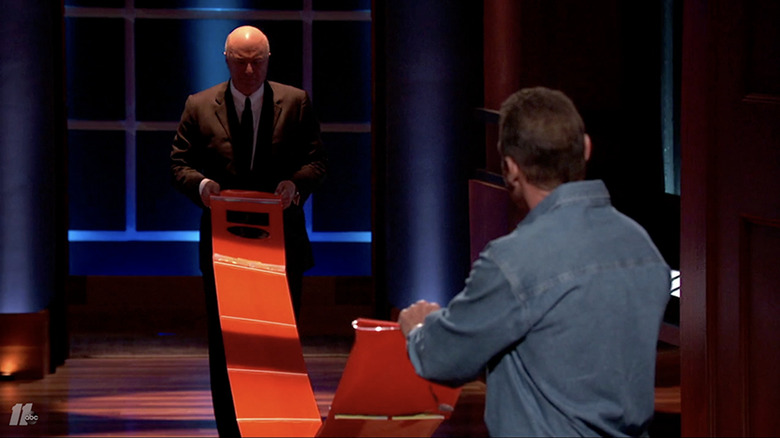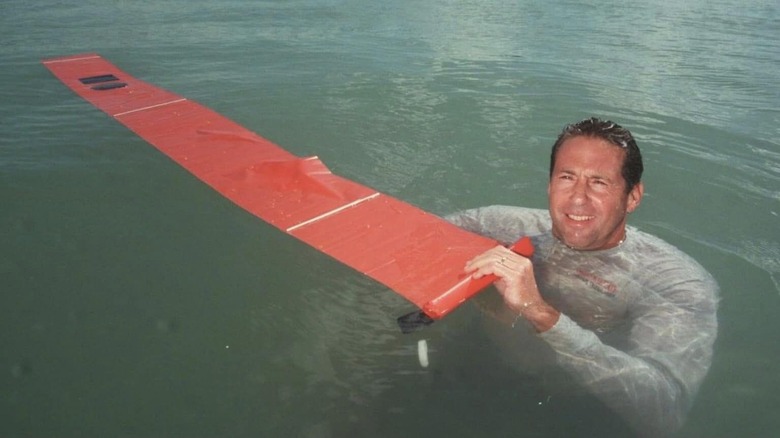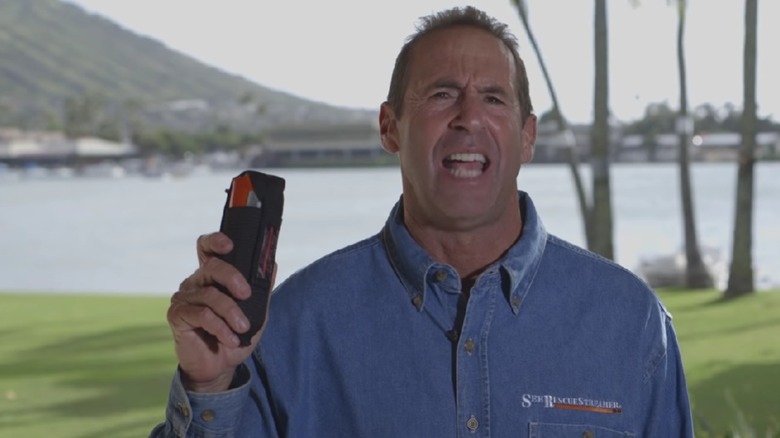What Really Came Of See/Rescue Streamer From Shark Tank?
Hopeful entrepreneurs on "Shark Tank" tend to peddle a lot of items that feel nice-to-have at best, or novelty items at worst. Occasionally, an inspiring inventor will come along with something that feels truly worthwhile rather than someone's impulse buy. That's what we got in Season 8 when Robert Yonover from Hawaii introduced his survival product.
The rugged volcanologist impressed the sharks with a no-nonsense pitch for his patented See/Rescue Streamer, a location device designed to catch the attention of rescuers in the event that someone is lost at sea or in the wilderness. His innovation was simple — a length of high-visibility material with lights and reflectors that rolls into a neat package weighing 13 ounces or less. Using before and after photos to demonstrate how difficult it is to spot a person floating in the vastness of the ocean, the life-saving capabilities of his product were clear for everyone to see.
Yonover claimed that his product had saved four lives already and that was more important to him than making money. The sharks were visibly impressed, and they were equally struck by his figures. His company had made $15 million in sales over a 15-year period, largely thanks to military approval and government contracts. It was convincing stuff from the straight-talking inventor, but could he get the deal he wanted to save more lives?
What happened to the See/Rescue Streamer on Shark Tank?
Robert Yonover entered the "Shark Tank" asking for $200,000 in return for 20% of See/Rescue. Impressed looks from the sharks started turning into reluctant frowns when he revealed that he wanted the money to rebirth the business after his licensing deal with the military had come to an end. His goal was to pursue both domestic markets and government contracts while also securing a mandate to make his device a standard feature on life jackets.
Question marks also arose about the necessity of the device now that GPS tracking is commonplace. Yonover countered by explaining that the See/Rescue had no electronics or chemicals and therefore couldn't fail, while GPS had the potential to go wrong at the worst possible moment.
Negotiations broke down because the sharks struggled with two factors. FUBU founder Daymond John felt the major play was a renewed deal with the government but didn't think he could help and dropped out. With her background in consumer products, Lori Greiner couldn't see the mass marketability and stepped back. Robert Herjavec felt the same way and quickly followed. Dallas Mavericks owner Mark Cuban loved the product but also wasn't convinced that his influence would help sell a military contract and didn't see the See/Rescue Streamer as a worthwhile investment in the domestic market. Lastly, Kevin O'Leary felt the device needed far too much work to launch again from scratch, leaving Yonover with no deal.
See/Rescue after Shark Tank
"Shark Tank" is generally geared towards celebrating success, but sometimes there is great entertainment value to be had from seeing an excruciatingly bad pitch or dodgy product walk away empty-handed. That certainly wasn't the case with the See/Rescue Streamer, and it was sad to see such an ingeniously simple device with real life-saving potential fail to get extra backing from the sharks.
Even without securing an investment, Rob Yonover's appearance on the show helped drive more sales after the episode aired. Happily, walking away empty-handed didn't hurt his business at all in the long run. He now supplies governments around the world and cites military approval from the United States Marines, Navy, Air Force, and Coast Guard, and his convincing website also lists testimonials from survivors whose lives have depended on the device for their own rescue.
In 2020, Yonover proudly announced that SpaceX had chosen his invention to protect astronauts traveling to the International Space Station on the historic first commercial flight. As of March 2022, the company reported an annual revenue of around $3.9 million, and the product is still available in the domestic market, ready to purchase on Amazon and outdoor lifestyle sites. The success of the See/Rescue Streamer is a feel-good story that just goes to show that failing to receive a deal from "Shark Tank" isn't always the end if you have a great product to sell.


